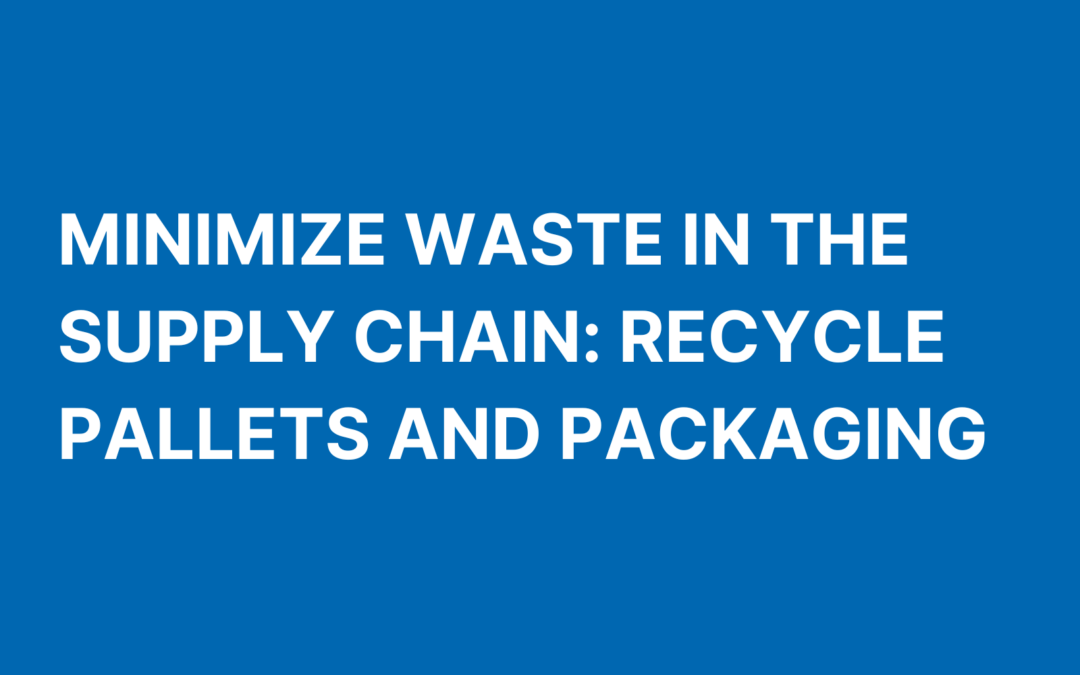Minimizing waste is imperative to long-term success in the supply chain. Excess waste hinders efficiency, harms the environment, and curbs growth and profitability. A sustainable, circular economy is recognized as a key component to a successful business model. According to the Environmental Protection Agency (EPA), a circular economy keeps materials and products in circulation for as long possible. The process minimizes material usage, redesigns products to be less resource intensive, and reclaims waste as a resource to generate new products and materials.
Ensuring waste management programs are optimized to their fullest extent throughout the entire supply chain remains mission critical. Even small, eco-friendly measures can produce meaningful results around sustainability—recycled pallets and plastic packaging are two prime examples.
Recycled Pallets Help Businesses and the Planet
Durable wooden pallets are a mainstay in the global supply chain, carrying vital goods between warehouses, suppliers, and customers. Do you know that pallets carry approximately 80% of all US commerce and account for greater than 46% of all hardwood lumber production in the United States? According to the National Wooden Pallet and Container Association, approximately two billion pallets are used daily in the United States alone. That is a substantial number—one that clearly necessitates the need for longstanding environmental concern and sustainability practices.
Recycled (or refurbished) wood pallets are ideal for the circular economy. Unlike the outdated linear “take-make-dispose” model, incorporating recycled pallets into the supply chain has a wide array environmental and economic benefits including:
Environmental Advantages:
- Decreases an organization’s carbon footprint – Building new pallets requires a substantial amount of energy and natural resources. By expanding the pallet lifecycle, organizations are demonstrating their commitment to conserving resources and saving the planet.
- Lowers the amount of waste in landfills – Reducing, reusing, and recycling decreases the amount of waste.
- Reduces the demand for freshly cut timber – Helps mitigate the negative effects of deforestation.
Economic Benefits:
- Considerable savings – Estimates indicate that a recycled pallet can save as much as 75% (compared to the purchase of a new pallet).
- Reduces procurement expenses – Recycled wooden pallets tend to be available at a lower cost; helps reduce procurement expenses for businesses.
- Stretches budgets farther – When businesses save money from a pallet recycling initiative, the money they save can be reinvested elsewhere.
Increase the Lifecycle of Plastic Packaging
According to the Supply Chain Solutions Center, 91% of packaging ends of up in landfills and/or in the environment.
The prevalence of non-biodegradable plastic packaging in the supply chain remains a top environmental concern. While plastic packaging is incredibly lightweight and durable, it has a major drawback—most plastic packaging ends up in landfills. This unnecessary waste negatively impacts the environment and can cause considerable harm to animals and their precious ecosystems. Reducing single-use plastics and encouraging the usage of biodegradable materials is an optimal way to lower long-term costs and promote sustainable business practices.
Here are a three useful ways to reduce packaging waste:
1. Use recycled or reusable materials – Seek environmentally-friendly alternatives to single-use disposable plastic/materials. New products are costly and consume a considerable number of natural resources.
2. Try smaller/smarter packaging – Rethink packaging design. Consider reducing the size of the packaging. Seek lighter, more eco-friendly materials, when possible.
3. Start a conversation with suppliers – Make a concerted effort to reduce waste and focus on initiatives that encourage and reward sustainability. Look for better solutions that will benefit all parties both environmentally and economically.
Look for Eco-friendly Solutions
As awareness for the circular economy heightens and the need for planet-friendly alternatives continues to escalate, the old adage, Reduce, Reuse, Recycle is more important than ever before. We must all do our part in the supply chain to promote a cleaner, more efficient, sustainable future for generations to come. Start a conversation with your team—and your suppliers—today about vital improvements your business can make.
About Kem Krest
Kem Krest, a certified minority business enterprise (MBE), is the nation’s leading provider of supply chain optimization solutions to automotive, powersports, and heavy-duty OEMs. Through our dedicated team members, lean operating system, and streamlined technology, Kem Krest ensures a resilient and uninterrupted supply chain for the programs we manage. Through customized end to end solutions that address every facet of the supply chain—from inventory management, fulfillment, warehousing, kitting, packaging, logistics, and transportation management, Kem Krest enables companies to increase operational efficiency, deliver superior customer and employee experiences, focus on growth initiatives, and achieve cost savings. Kem Krest partners with companies to virtualize their supply chains through a growing network of 12 facilities in the US and Canada, featuring 1.75M sq. ft. of warehouse space and 600+ full-time team members. For more information, please visit Kem Krest’s website at KemKrest.com.

